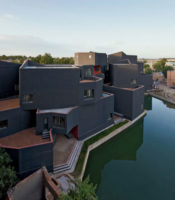Beijing, China
When architect Zhang Ke set up Standardarchitecture in Beijing, he chose the name because “it sounds neutral. It doesn’t imply any specific form,” he says. But for a studio that’s on a roll, in a country stuck in fast-forward, perhaps it’s equally fitting that the firm recently adopted the shorter alias START (as in Standard Architecture Team). “For every project, we want a completely new start, to throw off all preconceptions — like we’re almost pretending we don’t know anything,” says Zhang Ke. Founded in 2001, and now including partners Zhang Hong and Claudia Taborda (a Lisbon-based landscape architect), Standard is positioned at the forefront of China’s latest generation of emerging architects. It takes each brief as a new point of departure — a series of existing givens — and has shown itself flexible enough to explore projects both massive and small, spectacular and understated.
In Tibet, for example, the firm has built a number of much-praised projects in the Yalu Tsangpo Grand Canyon region, including the Yalu Tsangpo River Boat Terminal (2008), the Niyang River Visitor Center (2009), and the forthcoming Niangou Wharf. Quietly emerging from a landscape of dramatic mountains and pristine water, these modest projects consist of austere pavilions and meandering ramps constructed from locally gathered stone and timber. “They’re like experiments in how we can make contemporary architecture that feels like it’s actually growing out of the place,” Zhang Ke says.
On the other end of the spectrum, Standard has proposed a pair of 525-foot-tall skyscrapers of unevenly stacked floors, called the Dancing Books Towers, and has imagined enormous buildings that double as terraced rice paddies in Hong Kong. For this year’s inaugural Audi Urban Future Award, for which Standard was the only Chinese finalist, Zhang Ke suggested transforming Beijing’s main Ring Road arteries into giant conveyor belts for cars. “We focus a lot on the use of materials, but also urban spaces,” says Zhang Ke, 40, who holds master’s degrees from Harvard and from Beijing’s Tsinghua University. “We’re not bound by what’s already established or what’s known.”
The firm got its big break in 2001, when it won a competition to design a park around the ruins of Beijing’s Ming Dynasty city walls. Since then, Standard has stood out not so much for one thing — radical forms, a consistent methodology, an easily articulated polemic — but rather for its multifarious approaches. Its French-Chinese Art Center, in Wuhan, China, includes two angled cultural buildings connected by a 260-foot-long bridge, their concrete forms suggesting the brushstrokes of a Chinese scholar. Its Eggs of the City project for last year’s Shenzhen & Hong Kong Bi-City Biennale of Urbanism\Architecture proposed mobile living pods for migrant workers, using playful forms that immediately engage all kinds of people.
In many ways, Standardarchitecture tellingly reflects the current Chinese condition: Singular narratives are inadequate here, in a country undergoing enormous flux. There’s a need for subtlety as well as daring, for cultural continuity as well as breakaway change — in short, a neutral stance that offers the flexibility to experiment in divergent ways, plus an open-ended belief that anything is possible. “It’s a process of daydreaming,” Zhang Ke says of the firm’s work, “but at the same time it’s about realization, to bring these seemingly impossible things to life.”
Standardarchitecture
LOCATION:Beijing, China
FOUNDED: 2001
DESIGN STAFF: 25
PRINCIPALS: Zhang Hong (left), Zhang Ke (center), Claudia Taborda (right)
EDUCATION: Zhang Hong — Tsinghua, M.Arch., 1999; Southeast University, B.Arch., 1990. Zhang Ke — Harvard, M.Arch., 1998; Tsinghua, M.Arch., 1996; Tsinghua, B.Arch., 1993. Taborda — Harvard, M.L.A., 1999; University of York, M. Conservation Studies, 1991; University of Evora, Portugal, B.L.A., 1990
WORK HISTORY: Zhang Hong — Architectural Research & Design Institute of Tsinghua University, Beijing, 1999–2004. Zhang Ke — Zhang Ke Studio, New York, 1998–2001. Taborda — Global Arquitectura Paisagista, Lisbon, 1993–2005; Taba Arquitectos, Oeiras, Portugal, 1991–92
COMPLETED PROJECTS: Grand Canyon Museum and Restaurant, Tibet, 2010; Eggs of the City, Shenzhen, 2010; De Cafe, Beijing, 2009; Niyang River Visitor Center, Tibet, 2009; Yalu Tsangpo River Boat Terminal, Tibet, 2008; French-Chinese Art Center, Wuhan, 2005
CURRENT PROJECTS: Municipal Meeting Center, Beijing, 2010; Sports Club, Wuxi, 2011; “Ming” tray design for Alessi, 2011; Vanke Twin Towers, Tianjin, 2011; Elementary School, Quanzhou, 2012; Civic and Education Center, Jiading, 2012; Novartis Campus Building, Shanghai, 2014
WEB SITES: www.standardarchitecture.cn — www.star-t.cn












Post a comment to this article
Report Abusive Comment